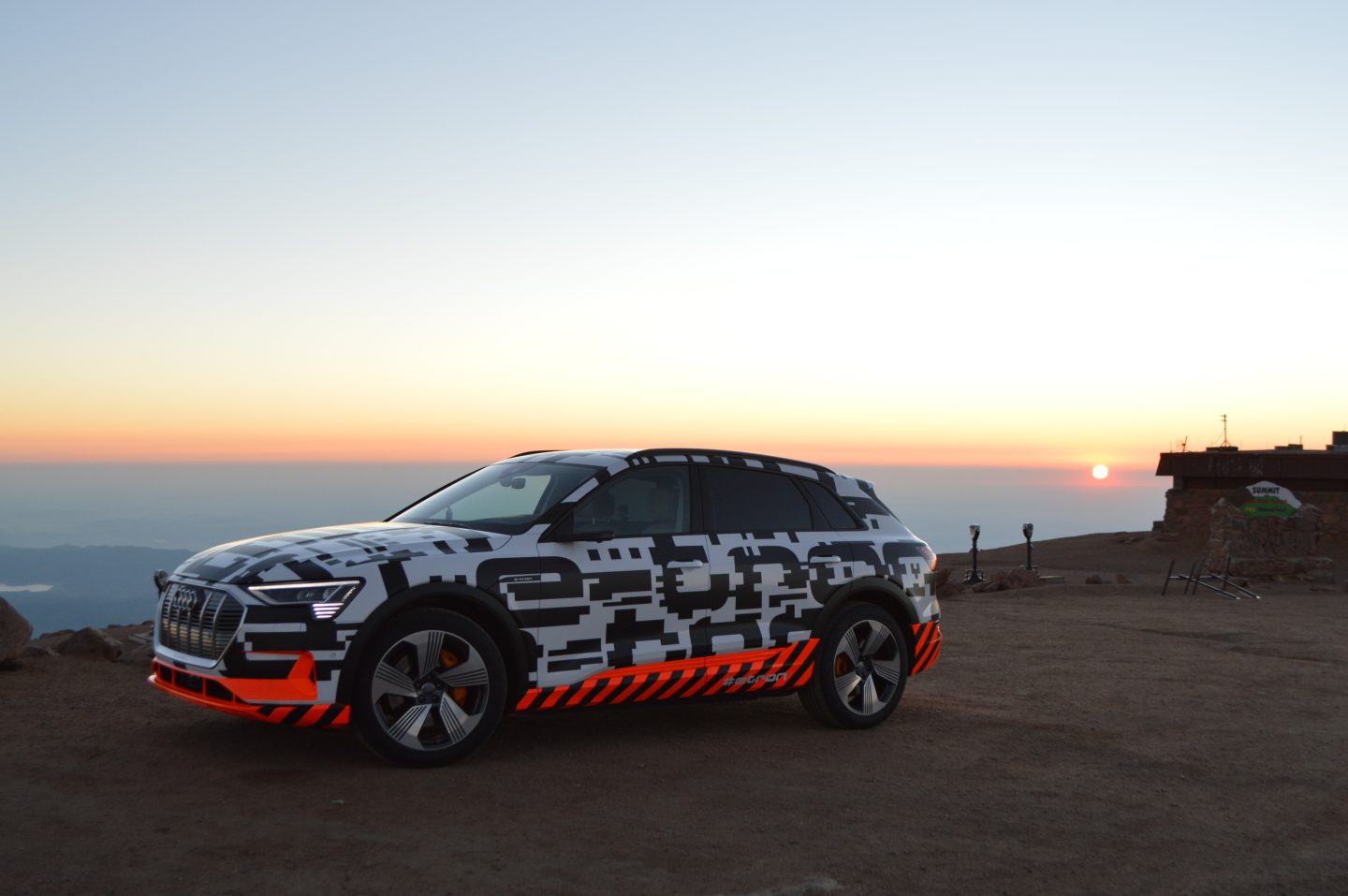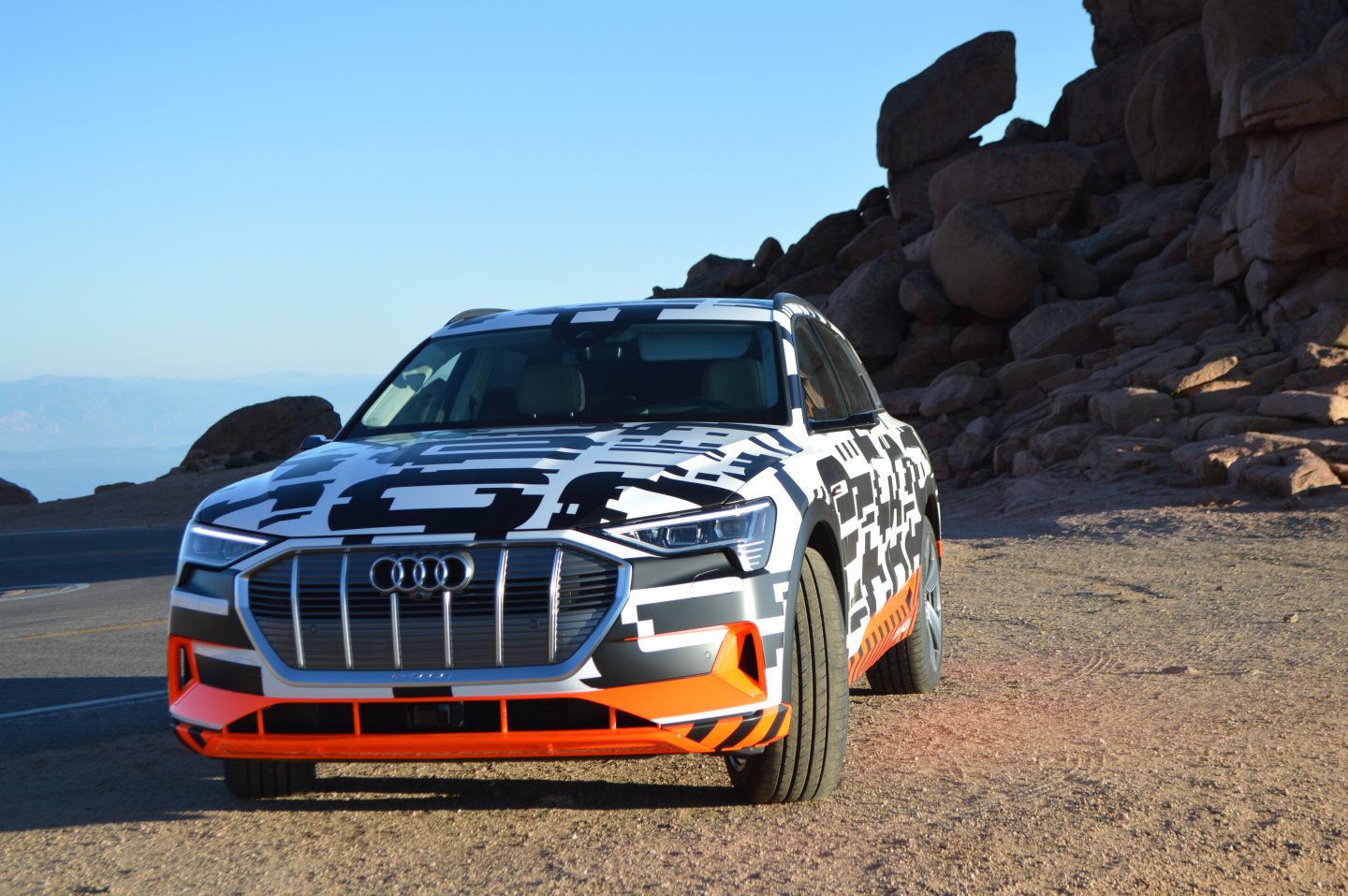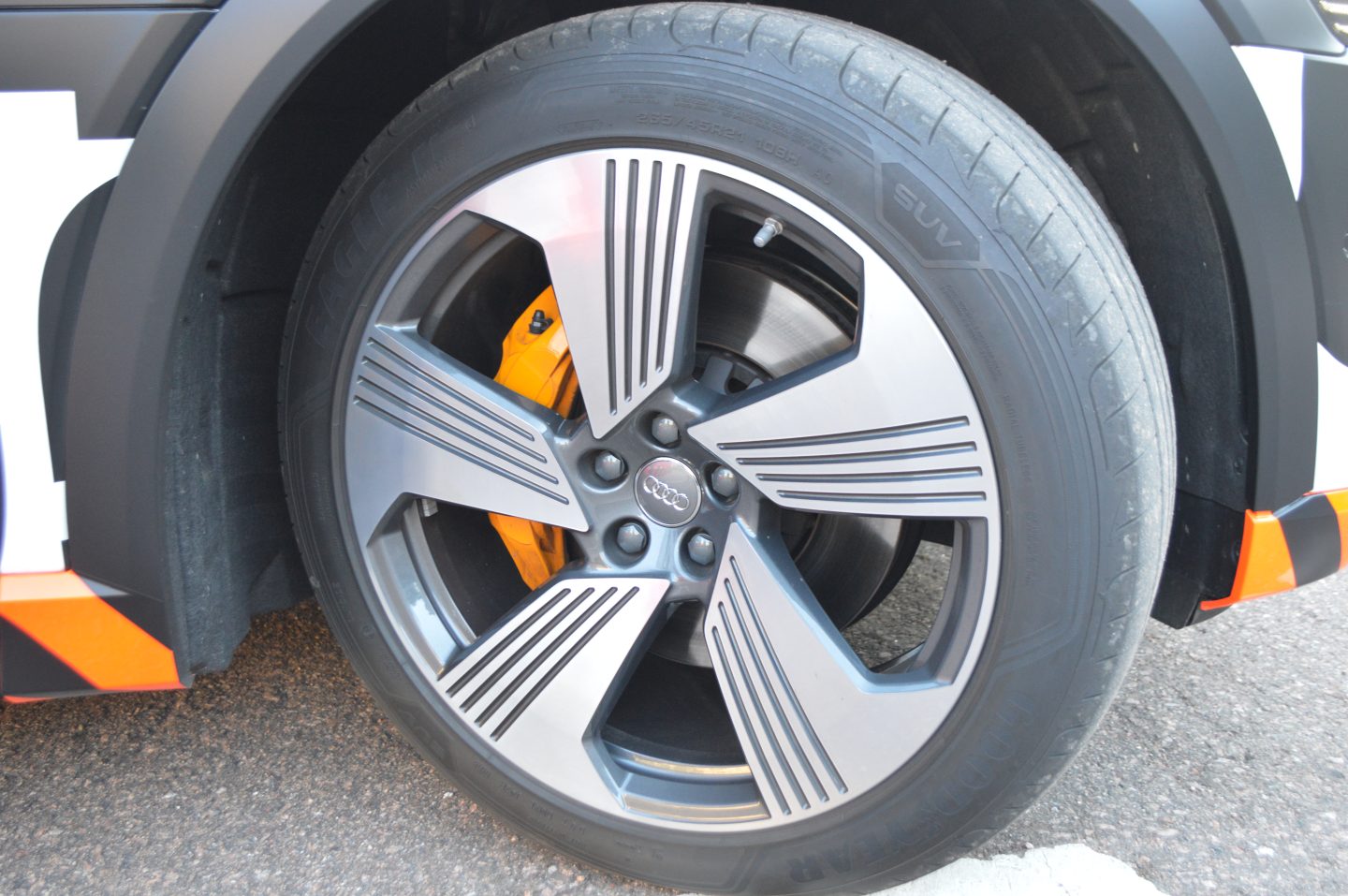Recuperating power: Charging a prototype Audi e-tron with kinetic energy


The battery has a range of 248.5 miles with the help of regenerative braking.
Last week, Audi invited a handful of journalists to go for a drive down Pike's Peak, one of Colorado's many mountain tops that rise more than 14,000 feet above sea level.

The rear of the prototype vehicle in the headlights of another one.
We rose before dawn and shuttled up the mountain to a frigid July sunrise overlooking the world. Waiting for us at the top were four all-electric prototype vehicles, camouflaged against unscrupulous photographers. They were new e-tron SUVs, outfitted for a European market but with aspirations of becoming Audi's American answer to Tesla's Model X. With 248.5 miles (400km) of range, a 95kWh battery, and dual-motor all-wheel drive, the car has the potential to be an electric all-terrain vehicle suitable for ski trips to Aspen.

Sunrise over Kansas.
As the sun inched its way up over Kansas, my fingers began to freeze. The 3:30am cup of coffee and the winding drive up the mountain and the thin, dry air all conspired to make me start feeling a bit sick. I hopped into one of these inscrutably decorated vehicles, hoping to take shelter from the high-altitude wind, and quickly noticed touch screens and paddle shifters and thin, not-yet-legal-in-America side-view cameras sticking out of the sides of the vehicle where mirrors ought to have been.

The front of Audi's prototype e-tron in the early dawn hours.
But the purpose of this drive was not to speculate on features, MSRP, and EPA fuel-equivalent numbers (all of that is still subject to change on the US version of the vehicle, which will likely be introduced in 2019). Instead, we were here to experience Audi's latest engineering developments: namely, the recuperation system that turns what would otherwise be kinetic energy, created during coasting and braking, into electrical energy. These features contribute to a full 30 percent of the prototype e-tron's range.

Oh, there's dawn.
Two braking systems
Regenerative braking and regenerative coasting are hardly new developments. But Audi's engineers have spent significant time optimizing the latter and getting it to work with the former in a way that maximizes recaptured energy and also offers a smooth drive.

The interior of Audi's prototype electric vehicle is screen-heavy.
Regenerative braking
Audi's e-tron SUV has two braking systems: an electronic braking system and a conventional, friction-based braking system. The electronic braking system usually responds when you're simply tapping the brakes: this initiates the regenerative braking system and captures that kinetic energy as electric energy.

Audi engineers cooked up this app to show when and how the car's recuperation system would be kicking in.
Such a graphic will likely not be available to regular customers, sadly.
However, if you apply more force to the brake, the brake control system knows you're trying to make a complete stop and initiates the standard hydraulic braking system. This hydraulic system won't capture any energy for you, but it will bring your vehicle to a complete stop.
The switch happens nearly instantaneously, and, in our test drive, it was imperceptible to me.

We stopped halfway down the mountain for a quick... brake. (I mean a break.)
"The control unit detects with how much force the driver is depressing the brake pedal and calculates how much braking torque is needed within milliseconds," an Audi press release writes. "If the recuperation torque is not sufficient, a displacement piston in the brake hydraulics generates additional pressure."

The vehicle is designed with aerodynamic concerns foremost.
When we were about halfway down the mountain, our driver, engineer Oswin Röder, pulled off the road to allow the passengers to stretch their legs and switch seats. A mandatory brake-check station awaited us, where a ranger usually uses a thermometer to see if you're at risk of burning out your brakes from all the downhill driving. Audi's prototype came in at a cool 48°F (9°C). Röder later invited us to touch the interior of the wheel on the brake rotor. I confirmed: all that kinetic energy that would have become heat had evidently become electric energy.

At the end of the drive, in the full, mid-morning sun, we look on the glory of the Garden of the Gods.
Regenerative coasting: Your car automatically knows how much to recuperate
Like with other battery electric vehicles, Audi's system can also recuperate energy as it coasts, drawing on the vehicle's two electric motors to create brake torque, which starts happening once you take your foot off the accelerator. You have a few options here, too. You can purely coast, which contributes nothing to regeneration. Or you can manually recuperate energy using the car's shift paddles, toggling between Level 1 and Level 2 settings, which adjust how much drag there is on the car's coast.

The driver's side-view camera screen is touch-sensitive, allowing the driver to adjust either mirror intuitively.
Additionally, you can set-it-and-forget-it with automatic coasting recuperation. This setting draws on the car's sensors, including a camera up front, to determine if you're coming up to a curve in the road or a wall of traffic on the highway. The system then adjusts the aggressiveness of the regenerative coasting accordingly. The slowing action of the brake torque on the electric motors creates what Audi calls a "one-pedal feeling," where you can slow the car without using the brake at all. That comes from Audi, of course: none of the journalists was allowed to drive the prototypes. We were just allowed to sit in them.

I just really like the view you get with these cameras.
Audi says that, with coasting and braking combined, energy is usually being generated during 90 percent of all decelerations.
This appeared true in practice: before the drive, the Audi team cooked up a small app connected to the vehicle's internal recuperation system, which showed us in real time exactly when Röder was recuperating energy, whether from the lack of acceleration or from the brake, and when he was expending energy in drive or when he hit the hydraulic brakes.

Currently, replacing side-view mirrors with cameras is not street-legal,
but Audi is hoping it will become legal in the US soon.
By the end of our journey down the mountain, we had pumped roughly 11kWh back into the battery. An Audi press release says that its regenerative braking system can recuperate up to 220kW at a time if the driver applies the brakes when they're going roughly 60 miles per hour.

The vehicle's brake rotor wasn't hot to the touch after a lot of downhill deceleration.
Throughout all this driving, the car is constantly calculating whether the front or the rear axle should be contributing to deceleration the most. Usually, the rear axle is the star of the show, but as the car takes a turn, it will intelligently move some regenerative drag torque to the front axle.

The driver's side-view camera screen is touch-sensitive, allowing the driver to adjust either mirror intuitively.
Of course, it's good to keep in mind that this is still just a prototype vehicle and a prototype vehicle with EU specs at that (the specs will inevitably change for the US market, notably those side-view mirrors, barring a stroke of good sense from the federal government).
A few notes about the rest of the car, which will likely change
The drive last week was very focused: journalists did not get to drive the e-trons, and nearly every question about non-recuperation features on the car was met with the disclaimer that the answer is subject to change. More details will be available when the SUV is officially announced on September 17. Still, we can say that the aerodynamics of the car were a primary concern for Audi, to the point that these e-tron SUVs had specially designed wheels that streamlined the gap between the wheel and the rim and specially designed lettering, also for aerodynamic purposes.
The side-view cameras also caught everyone's eye. Although I used to be a skeptic about this, especially after reading Ars comments along the lines of "mirrors are a simple tool, impervious to hacking, that has worked for thousands of years!" I now disagree. On this e-tron, the cameras' fields of vision were elegantly shown in a small triangular space inside the side-view camera's door, and the image was way better than anything you'd get with a mirror. Removing side-view mirrors doesn't do much for aerodynamic effect at normal passenger vehicle speeds, but it does make highway driving quieter, and that's a laudable goal.
Plus, good old-fashioned mirrors can be "hacked," too: a friend of mine was in college when an unknown drunken reveller roundhouse-kicked the side-view mirror off the driver's side of her vehicle. It's a cruder crime than hacking a camera, but both are solved by making sure you look over your shoulder when you change lanes (like you should be doing anyway) on your way to the shop to get it fixed.
Although we were mostly cruising the winding road down the mountain slowly, we did get a moment on the highway as we returned to the hotel outside Colorado Springs. Here, Röder stepped on the gas, and like all good electric vehicles, the acceleration was instantaneous, and the ride was quieter than you'd find in a gas vehicle.
Finally, sitting inside the e-tron was very comfortable. The interior climate is augmented with a heat pump that allows the car to recuperate heat from the battery, yet another nod to the efficiency of this vehicle. Seats can be heated or cooled, and there was plenty of space in both the front and the back for my legs and my laptop bag. So, as a passenger, the drive was great. As a driver concerned about range and comfort, I'm sure it'll be even better.
 Megan Geuss is a staff editor at Ars Technica. She writes breaking news and has a background in fact-checking and research.
Megan Geuss is a staff editor at Ars Technica. She writes breaking news and has a background in fact-checking and research.
Tags
Who is online
49 visitors

I love cars... and this is a peek at the future...
Love the rear view cameras ( less drag coefficient? )
If you have ever priced a mirror assembly lately for a large GM or Ford SUV, you would know the prices are ridiculously high;
so if they are already spending thousands on plastic mirrors why not have rear vision cameras if the cost is comparable?
Yes. They seem like a no-brainer to me... but I remember how long it took to get past sealed-beam headlights...